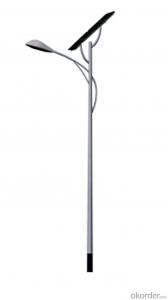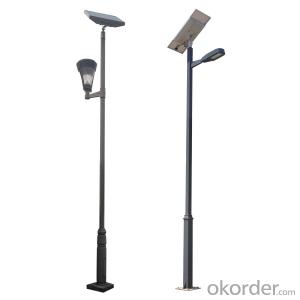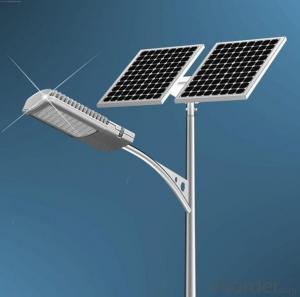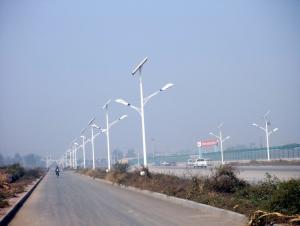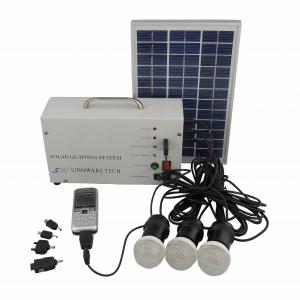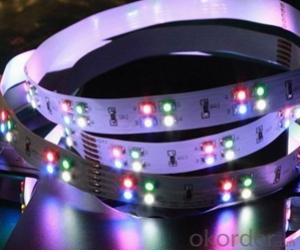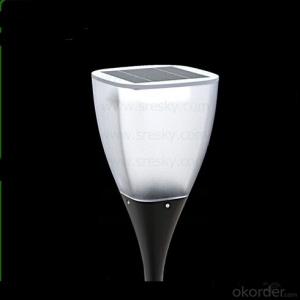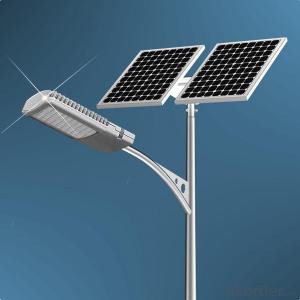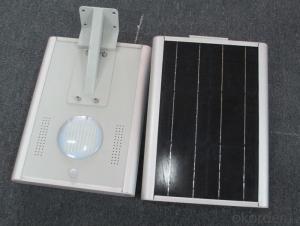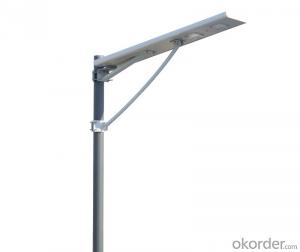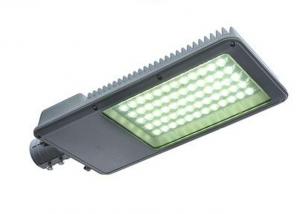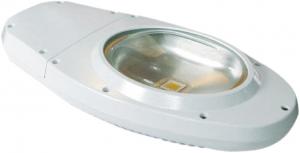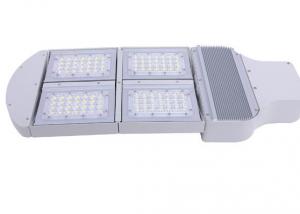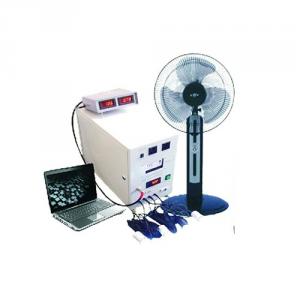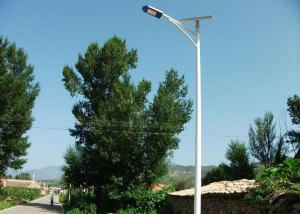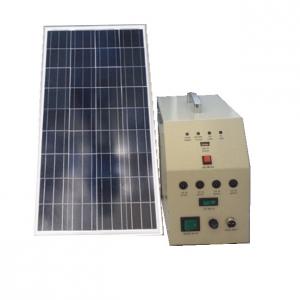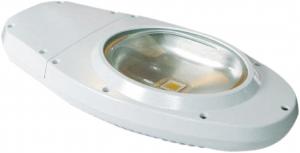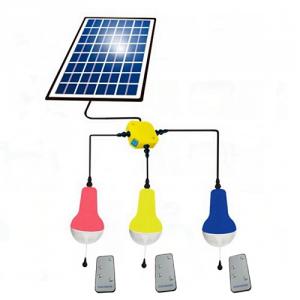Solar street light new energy good looking 001
- Loading Port:
- Ningbo
- Payment Terms:
- TT or LC
- Min Order Qty:
- 1 set
- Supply Capability:
- 5000 set/month
OKorder Service Pledge
OKorder Financial Service
You Might Also Like
1, Product desciption
Inverter circuits designed to produce a variable output voltage range are often used within motor speed controllers.
The DC power for the inverter section can be derived from a normal AC wall outlet or some other source. Control and feedback circuitry is used to adjust the final output of the inverter section which will ultimately determine the speed of the motor operating under its mechanical load.
Motor speed control needs are numerous and include things like: industrial motor driven equipment, electric vehicles, rail transport systems, and power tools. (See related: variable-frequency drive ) Switching states are developed for positive, negative and zero voltages as per the patterns given in the switching Table.
The generated gate pulses are given to each switch in accordance with the developed pattern and thus the output is obtained.
Solar power is energy from the sun. "Solar" is the Latin word for "sun" and
And Powerful source of energy. Without it, there will be no life.
Solar energy is considered as a serious source of energy for many years
of the vast amounts of energy that is made freely available, if harnessed by modern technology.
A magnifying glass can be used to heat up a small amount of water.
The short piece of copper tube is sealed at one end and filled with water.
And magnifying glass is then used to warm up the pipe.
Using more than one magnifying glass will increase the temperature more rapidly.
2, Features of the product
Inverters convert low frequency main AC power to higher frequency for use in induction heating.
To do this, AC power is first rectified to provide DC power. The inverter then changes the DC power to high frequency AC power. Due to the reduction in the number of DC Sources employed, the structure becomes more reliable and the output voltage has higher resolution due to an increase in the number of steps so that the reference sinusoidal voltage can be better achieved.
This configuration has recently become very popular in AC power supply and adjustable speed drive applications. This new inverter can avoid extra clamping diodes or voltage balancing capacitors. There are three kinds of level shifted modulation techniques, namely:
The first thing to figure out is the length of road in need of street lights.
This can be a small entrance road only a couple hundred of feet long to miles of streets through an area. Does the area currently have any type of lighting available.
What is the reason for needing street lights in this area
Is the electrical grid already nearby or would you need to call in the power company to bring in electrical lines.
If the electric needs to be brought to the area, how much is this going to cost? Depending on how far the grid electric is from the location of the needed lighting, this can be quite expensive.
How much lighting is needed on the street? Do the lights need to be dark sky compliant.
Do the street lights need to run from dusk to dawn or for only a specified number of hours at night.
Are the street lights able to dim in the middle of the night and still provide enough lighting.
These questions need to be answered before you can decide on how many lights you will need to complete the project.
3, Detailed Specification
| ||||||||||||||||||||||||||||||||||||||||||||||||
4, Product Image
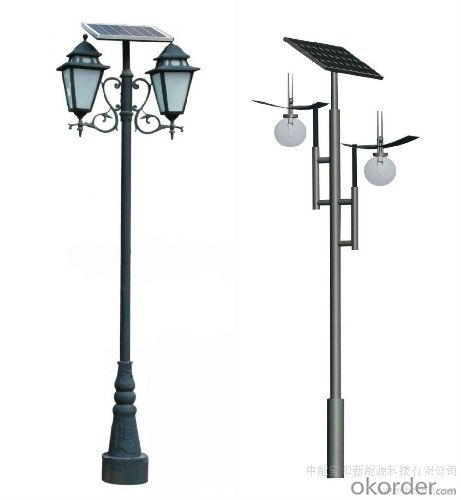
- Q:Can solar lights be used for illuminating outdoor stairways?
- Indeed, outdoor stairways can definitely be illuminated using solar lights. They are actually an excellent option for this purpose. The design of solar lights allows them to capture and store energy from the sun during the day. This stored energy is then utilized to power the lights at night. Consequently, no electrical wiring or connection to the power grid is necessary, making the installation of solar lights in outdoor stairways a hassle-free process. Typically, solar lights are equipped with light sensors that automatically activate the lights as darkness sets in. This feature ensures that your outdoor stairways are adequately illuminated throughout the night. Furthermore, solar lights are available in a variety of designs and styles. You can find stake lights, wall-mounted lights, and even lights that are integrated into handrails or steps themselves. Using solar lights for outdoor stairways offers numerous advantages. Firstly, they are energy-efficient and environmentally friendly since they rely solely on solar energy. Secondly, they are cost-effective as they eliminate the need for electrical wiring and reduce electricity bills. Moreover, solar lights require minimal maintenance and have a long lifespan. When selecting solar lights for outdoor stairways, it is crucial to consider factors such as the amount of sunlight the area receives, the brightness and range of the lights, and the overall aesthetics of the lights to match your outdoor decor. With careful selection and proper placement, solar lights can effectively and safely illuminate outdoor stairways, enhancing both the safety and beauty of your outdoor space.
- Q:Can solar lights be used on flagpoles or outdoor flag displays?
- Yes, solar lights can be used on flagpoles or outdoor flag displays. In fact, they are a popular and environmentally-friendly option for illuminating flags during the night. Solar lights are designed to harness energy from the sun and convert it into electricity, which is then used to power the lights. They typically come with a small solar panel that needs to be installed in a location where it can receive direct sunlight. Once charged, solar lights can provide a steady source of illumination for several hours, depending on the specific model and the amount of sunlight received. This makes them ideal for flagpoles or outdoor flag displays as they do not require any wiring or electrical connections, making installation and maintenance hassle-free. Additionally, solar lights are often equipped with sensors that automatically turn the lights on at dusk and off at dawn, ensuring that the flag is properly illuminated throughout the night.
- Q:Are solar lights suitable for remote research stations?
- Yes, solar lights are suitable for remote research stations. These stations are often located in remote and isolated areas where access to electricity is limited or non-existent. Solar lights provide a reliable and sustainable source of lighting without the need for a grid connection or the use of fuel-based generators. Solar lights are powered by the sun, which means they can harness solar energy during the day and store it in batteries for use during the night. This ensures continuous lighting without the need for manual recharging or refueling. Additionally, solar lights are easy to install and require minimal maintenance, making them ideal for remote locations where regular maintenance may be challenging. Furthermore, solar lights are environmentally friendly, as they do not produce any greenhouse gas emissions or contribute to air pollution. This is particularly important in remote research stations, where preserving the natural environment and minimizing human impact is a priority. Overall, solar lights are a practical and sustainable lighting solution for remote research stations, providing reliable lighting, reducing dependence on fossil fuels, and minimizing environmental impact.
- Q:How do solar lights handle windy conditions?
- Solar lights are designed to be durable and withstand various weather conditions, including wind. Most solar lights are equipped with sturdy materials such as high-quality plastic or metal that can withstand wind speeds of up to 50 miles per hour or more. Additionally, they are often designed with features such as stake or anchor systems to secure them firmly into the ground, preventing them from being blown away by strong winds. Some solar lights also come with adjustable or flexible components, such as the solar panel or light head, which allow them to better handle windy conditions. These adjustable parts can be positioned in a way that minimizes the wind resistance, reducing the chances of the lights being damaged or knocked over. Moreover, solar lights are designed with a low center of gravity to enhance their stability. This helps prevent them from tipping over or being blown away even in strong gusts of wind. Manufacturers also consider aerodynamics while designing solar lights to minimize their wind resistance and increase their overall stability. However, it is important to note that extremely severe weather conditions, such as hurricanes or tornadoes, can pose a greater challenge for solar lights. In such cases, it is advisable to take precautions by temporarily removing the lights or securing them indoors until the weather conditions improve. Overall, solar lights are engineered to handle windy conditions and are generally reliable, durable, and capable of withstanding the forces of nature.
- Q:How do you choose the right solar panel size for solar lights?
- To choose the right solar panel size for solar lights, you should consider the power requirements of the lights, the amount of sunlight available in your location, and the battery capacity. Calculate the total wattage of the lights and select a solar panel that can generate enough power to meet that demand. Additionally, ensure that the solar panel size is suitable for the available space and can capture sufficient sunlight to charge the batteries adequately.
- Q:Can solar lights be used in areas with high levels of dust or dirt?
- Yes, solar lights can be used in areas with high levels of dust or dirt. However, it is important to note that the effectiveness and efficiency of the solar lights may be affected in such conditions. Dust and dirt can accumulate on the solar panels, reducing their ability to absorb sunlight and convert it into energy. This can result in decreased performance and shorter lighting duration. To ensure optimal performance, regular maintenance and cleaning of the solar panels are crucial in areas with high levels of dust or dirt. Periodic cleaning with a soft cloth or brush can help remove any accumulated dust, dirt, or debris that might hinder the solar panels' functionality. Additionally, positioning the solar lights in a way that minimizes exposure to dust or dirt can also help maintain their effectiveness. Despite the challenges, solar lights can still provide illumination in areas with high levels of dust or dirt, offering a sustainable and energy-efficient lighting solution.
- Q:Are solar lights suitable for boat docks?
- Yes, solar lights are suitable for boat docks as they are energy-efficient, environmentally friendly, and provide sufficient lighting for safety and visibility. Additionally, they eliminate the need for wiring or electricity, making them a convenient and cost-effective option for boat dock lighting.
- Q:Can solar lights be used for outdoor sports stadiums or arenas?
- Yes, solar lights can be used for outdoor sports stadiums or arenas. Solar lights are a sustainable and cost-effective option for illuminating large outdoor spaces. They can provide sufficient lighting for sports activities and events, while also reducing energy consumption and carbon emissions. Additionally, solar lights can be easily installed and require minimal maintenance, making them a practical choice for outdoor sports venues.
- Q:Are solar lights suitable for disaster relief or emergency response operations?
- Yes, solar lights are suitable for disaster relief or emergency response operations. They are portable, easy to deploy, and do not require an external power source. Solar lights can provide essential lighting in areas affected by disasters or emergencies, aiding rescue and relief efforts, improving safety, and enabling basic activities during power outages. Additionally, solar lights are environmentally friendly and sustainable, reducing the reliance on fossil fuels in these critical situations.
- Q:Do solar lights have adjustable brightness settings for different activities?
- Yes, some solar lights do have adjustable brightness settings to cater to different activities and preferences.
1. Manufacturer Overview |
|
|---|---|
| Location | |
| Year Established | |
| Annual Output Value | |
| Main Markets | |
| Company Certifications | |
2. Manufacturer Certificates |
|
|---|---|
| a) Certification Name | |
| Range | |
| Reference | |
| Validity Period | |
3. Manufacturer Capability |
|
|---|---|
| a)Trade Capacity | |
| Nearest Port | |
| Export Percentage | |
| No.of Employees in Trade Department | |
| Language Spoken: | |
| b)Factory Information | |
| Factory Size: | |
| No. of Production Lines | |
| Contract Manufacturing | |
| Product Price Range | |
Send your message to us
Solar street light new energy good looking 001
- Loading Port:
- Ningbo
- Payment Terms:
- TT or LC
- Min Order Qty:
- 1 set
- Supply Capability:
- 5000 set/month
OKorder Service Pledge
OKorder Financial Service
Similar products
New products
Hot products
Related keywords
